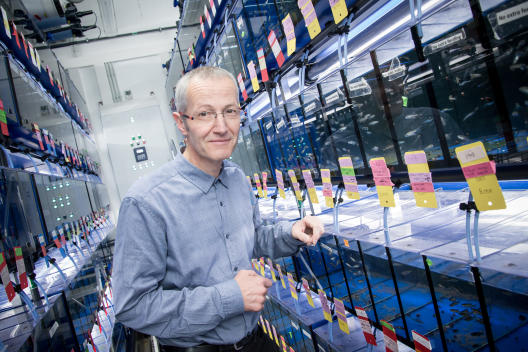Fish in research

They are just about five centimetres long and have pretty, silvery stripes. Zebrafish are popular with amateur fish breeders. In Münster, however, the fish don’t swim around just like that – they do so to support science. Around 13,000 zebra fish, for example, belong to developmental geneticist Prof. Stefan Schulte-Merker, a group leader at the Cells-in-Motion Cluster of Excellence and Director of the Institute for Cardiovascular Organogenesis and Regeneration at the University of Münster. He and the members of his group use the fish to carry out research into how bones, blood vessels and the lymphatic system develop.
Worldwide there are around one thousand groups of scientists working with zebrafish, which are eminently suitable for modern research. Fish embryos develop outside the mother’s body and are transparent in the first five days. “This is why, under the microscope, we can observe very closely how the blood vessels and lymphatic vessels develop in the fish,” says Stefan Schulte-Merker. And this happens at a rapid pace: after 26 hours the heart starts beating, and after 28 hours the first red blood cells start moving through arteries and veins.
One further advantage that zebra fishoffer is that keeping them and breeding them is pretty straightforward and easy to manage. The fish swim around in small groups in aquariums which can be stacked up to the ceiling. Special filtering equipment ensures the water quality is consistantly kept at optimum levels. And the breeding process is practically automatic. “If we bring males and females together, they usually begin spawning straight away, and within a very short space of time we have a hundred eggs from each pair,” Stefan Schulte-Merker explains. However, the fish have to feel at ease for this to happen, and that is why the researchers keep a constant eye on them.
Stefan Schulte-Merker has been carrying out research with and on zebrafish for over 20 years now. As a result of his findings, there is progress in our understanding of how our blood and lymphatic vessel system develops – as well as of why things sometimes go wrong in human patients. This is because the vessels in humans develop in the same way as in fish. “Fish are more similar to us than many of us realize,” says Stefan Schulte-Merker. “Nature doesn’t change the principle of how the bones, the heart or the lymphatic system develop.”
In his zebrafish, the CiM researcher looks specifically for genetic defects which influence the growth of the blood and lymphatic vessel system in the fish – and thus in humans too. In 2009, for example, his team discovered that the CCB1 gene is responsible for the so-called Hennekam syndrome. Lymphatic vessels do not develop normally in patients who have this genetic defect. As a result, the lymphatic system cannot carry away any superfluous fluid, and arms and legs swell up. Patients also suffer from mental disorders. Stefan Schulte-Merker now works in close cooperation with physician Raul Hennekam, who was the first to describe the symptoms and had for years been looking for the cause of the disease – until he came across Stefan Schulte-Merker’s research. What both the physician and the researcher now hope for is that one day they will be able to treat this vascular disease – and others like it.
But there is still a long way to go until then. Today, people from families with this syndrome can undergo genetic testing to see whether they are carriers of the disease. In Münster, research continues on gene CCB1. “We’re using fish to study whether the process whereby lymphatic vessels are formed can be stimulated,” says Stefan Schulte-Merker. If their experiments are successful, the first attempts could be undertaken to find a treatment for Hennekam syndrome and similar diseases.

